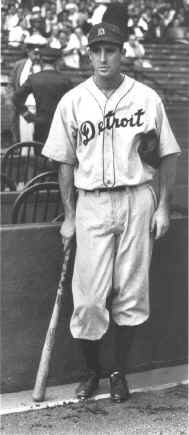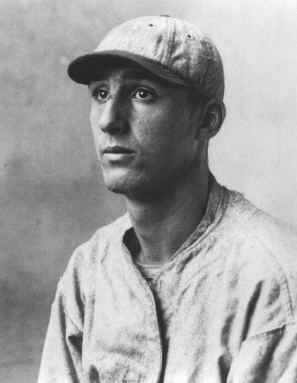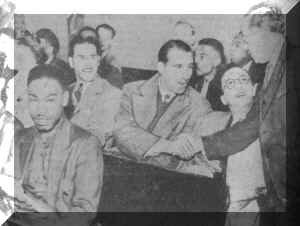|
Hank Greenberg |
|||||
|
In May 1941, seven months before the United States entered World War II, Greenberg became the first AL player to be drafted into the Army. He was discharged two days before Pearl Harbor, but re-enlisted after the Japanese attack, making it clear that he regarded himself as a role model not only for big league players but also for Jews generally. The first major leaguer to return to baseball after the war in Europe ended (he was discharged in the summer of 1945), he sealed another Detroit pennant with a grand slam on the final day of the season. Then he led the Tigers to a seven-game World Series triumph over the Cubs with a .304 average, two homers and seven RBI.
Hank Greenberg Born: Jan. 1, 1911Baseball 1B led AL in HRs and RBI 4 times each; 2-time MVP (1935,40) with Detroit; 331 career HRs, including 58 in 1938. Died: Sept. 4, 1986
Beyond his legacy as a role model, Greenberg was a fantastic ballplayer. His statistical line is flattened by his having missed four full years in World War II (he was drafted in 1941, before the war started, so lost an extra year compared to most major leaguers who served), which would have been his stat-fattening 31st through 35th years. He still ended up with the fifth-highest slugging percentage of all-time, the third-best RBI per game rate (for what that's worth), and was a two-time MVP (the first to win the MVP at two different positions) in the era of Gehrig and DiMaggio and Foxx. He was a key part of three pennant-winning clubs, and his comeback in late 1945 to lead the Tigers to the World Series title is one of the great stories in baseball history. Encyclopedia: Hank GreenbergBorn January 1, 1911 in New York City, NY, US Married: in 1946 to Coral Gimbel (of the family of New York department store fame) Died September 4, 1986 in Beverly Hills, CA, US Gravesite: Hillside Memorial Park Cemetery, Culver City, California Playing career: Detroit Tigers 1930, 1933-1946; Pittsburgh Pirates 1947. Positions: First base and outfield. Awards: American League Most Valuable Player, 1934 and 1940. American League All-Star team, 1937-1940. Elected to the United States Baseball Hall of Fame in 1956. Link to the Hank Greenberg page at the Baseball Hall of Fame website Greenberg was not the first Jewish man to play major-league baseball. But he was, during his career, by far the best Jewish player ever. Only Sandy Koufax has had similar success among Jewish players in the 50 years since Greenberg has retired. Greenberg was subject to the most vicious ethnic taunting seen in the sport prior to the arrival of Jackie Robinson in 1947, Greenberg nevertheless became a first-rank ballplayer and an icon among Jews in the United States. In his career, he only played nine full seasons. He missed three full seasons and most of two others to military service during World War II, and missed most of another season with a broken wrist. In seven of the nine years in which he was active, he was one of the dominant players in the game, beginning in 1934, his second major-league season, in which he won his first MVP award and helped the Tigers reach their first World Series in 25 years. As a fielder, the 6'4" Greenberg was awkward and unsure of himself early in his career, but he mastered his first-base position through countless hours of practice. When he was asked to move to the outfield in 1940 to make room for Rudy York, he worked tirelessly to master that position as well. A prodigious home-run hitter, he narrowly missed breaking Babe Ruth's single-season home-run record in 1938 when he hit 58 home runs. The story goes that several pitchers intentionally walked Greenberg towards the end of the season rather than give a Jewish man a chance to break Babe Ruth's record. (There is some reason to dispute this as a motive. It is true that the Cleveland Indians did not give Greenberg good pitches to hit during the last week of the season; it is also true that Detroit and Cleveland were battling for third place, which in those days carried with it a share of World Series profits, so Cleveland players had a financial interest in keeping Greenberg from hitting home runs.) For his own part, Greenberg felt that runs batted in were more important than home runs. He would tell his teammates, "just get on base", or "just get the runner to third", and he would do the rest. He batted in 170 runs in 1935 and in 1937 topped that with 183 (a figure bettered only by Hack Wilson in 1930 and Lou Gehrig in 1931). After moving to the outfield in 1940, Greenberg led the Tigers to a pennant and won his second MVP award. He then entered military service in 1941. When the United States entered World War II, Greenberg remained in uniform, until the summer of 1945. Without the benefit of spring training, he returned to the Tigers and helped lead them to a come-from-behind American League pennant, clinching it with a grand-slam home run on the final game of the season. In 1946 he returned to peak form. It is often estimated that Greenberg, had he played in another era uninterrupted by war, would have amassed over 500-600 home runs and 1,800-2,000 RBI. As it is, his totals of 331 home runs and 1,276 RBI are amazing for a 1,394-game career. He also hit for average, batting .313. In 1947, Greenberg and the Tigers had a lengthy salary dispute. When Greenberg decided to retire rather than play for less, Detroit traded him to the Pittsburgh Pirates. To persuade him not to retire, Pittsburgh made Greenberg the first baseball player to earn over $100,000 in a season (though the exact amount is a matter of some dispute). Team co-owner Bing Crosby recorded a song, "Goodbye, Mr. Ball, Goodbye" with comedian Groucho Marx and Greenberg, to celebrate Greenberg's arrival. The Pirates also moved in the seats in Forbes Field's cavernous left field, renaming the section "Greenberg's Gardens", to accommodate Greenberg's pull-hitting style. Greenberg played first base for the Pirates for 1947, during which he was remarkable for being one of the few opposing players to give encouragement to Jackie Robinson during his ordeal. The following year, Greenberg retired from the field to become the Cleveland Indians' farm system director and two years later, their general manager. His contributions in finding and developing talent helped contribute to that team's successes through the 1950s. He followed Bill Veeck to the Chicago White Sox, as part-owner, then retired from baseball in 1963 to go into investment banking.
|
|||||
|
Page last revised
James D. West www.IndianaMilitary.org |
 In
the 1930s Jewish Mothers would ask their sons: "What kind of day did Hank
have?" Hank Greenberg, the Detroit Tigers slugger who came close to
breaking Babe Ruth's homerun record, was baseball's first Jewish star.
Tall (6'4"), handsome, and uncommonly good-natured, Greenberg was a
secular Jew from the Bronx who became "the baseball Moses," an icon for
everyone from Walter Matthau ("I joined the Beverly Hills tennis club to
eat lunch with him. I don't even play tennis") to Alan Dershowitz ("I
thought he'd become the first Jewish president").
In
the 1930s Jewish Mothers would ask their sons: "What kind of day did Hank
have?" Hank Greenberg, the Detroit Tigers slugger who came close to
breaking Babe Ruth's homerun record, was baseball's first Jewish star.
Tall (6'4"), handsome, and uncommonly good-natured, Greenberg was a
secular Jew from the Bronx who became "the baseball Moses," an icon for
everyone from Walter Matthau ("I joined the Beverly Hills tennis club to
eat lunch with him. I don't even play tennis") to Alan Dershowitz ("I
thought he'd become the first Jewish president").



